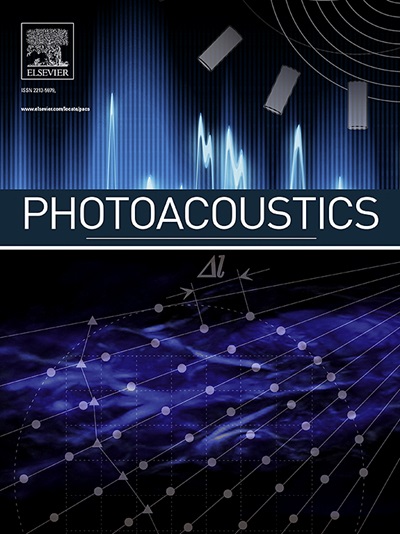Spectroscopic photoacoustic denoising framework using hybrid analytical and data-free learning method
IF 7.1
1区 医学
Q1 ENGINEERING, BIOMEDICAL
引用次数: 0
Abstract
Spectroscopic photoacoustic (sPA) imaging uses multiple wavelengths to differentiate and quantify chromophores based on their unique optical absorption spectra. This technique has been widely applied in areas such as vascular mapping, tumor detection, and therapeutic monitoring. However, PA imaging is highly susceptible to noise, leading to a low signal-to-noise ratio (SNR) and compromised image quality. Furthermore, low SNR in spectral data adversely affects spectral unmixing outcomes, hindering accurate quantitative PA imaging. Traditional denoising techniques like frame averaging, though effective in improving SNR, can be impractical for dynamic imaging scenarios due to reduced frame rates. Advanced methods, including learning-based approaches and analytical algorithms, have demonstrated promise but often require extensive training data and parameter tuning. Moreover, spectral information preservation is unclear, limiting their adaptability for clinical usage. Additionally, training data is not always accessible for learning-based methods. In this work, we propose a Spectroscopic Photoacoustic Denoising (SPADE) framework using hybrid analytical and data-free learning method. This framework integrates a data-free learning-based method with an efficient BM3D-based analytical approach while preserving spectral integrity, providing noise reduction, and ensuring that functional information is maintained. The SPADE framework was validated through simulation, phantom, in vivo, and ex vivo studies. These studies demonstrated that SPADE improved image SNR by over 15 in high noise cases and preserved spectral information (R > 0.8), outperforming conventional methods, especially in low SNR conditions. SPADE presents a promising solution for preserving the accuracy of quantitative PA imaging in clinical applications where noise reduction and spectral preservation are critical.
使用混合分析和无数据学习方法的光谱光声去噪框架
光谱光声成像(sPA)利用不同波长的光吸收光谱来区分和量化发色团。该技术已广泛应用于血管制图、肿瘤检测和治疗监测等领域。然而,PA成像非常容易受到噪声的影响,导致低信噪比(SNR)和受损的图像质量。此外,光谱数据的低信噪比对光谱分解结果不利,阻碍了准确的定量PA成像。传统的去噪技术,如帧平均,虽然可以有效地提高信噪比,但由于帧率降低,对于动态成像场景可能不切实际。先进的方法,包括基于学习的方法和分析算法,已经证明了前景,但通常需要大量的训练数据和参数调整。此外,光谱信息保存不明确,限制了其临床应用的适应性。此外,基于学习的方法并不总是可以访问训练数据。在这项工作中,我们提出了一个光谱光声去噪(SPADE)框架,使用混合分析和无数据学习方法。该框架将基于无数据学习的方法与高效的基于bm3d的分析方法集成在一起,同时保持频谱完整性,提供降噪功能,并确保功能信息得到维护。通过模拟、模拟、体内和离体研究验证了SPADE框架。这些研究表明,在高噪声情况下,SPADE将图像的信噪比提高了15 dB以上,并保留了光谱信息(R >;0.8),优于传统方法,特别是在低信噪比条件下。SPADE提出了一种有前途的解决方案,用于在临床应用中保持定量PA成像的准确性,其中降噪和光谱保存至关重要。
本文章由计算机程序翻译,如有差异,请以英文原文为准。
求助全文
约1分钟内获得全文
求助全文
来源期刊

Photoacoustics
Physics and Astronomy-Atomic and Molecular Physics, and Optics
CiteScore
11.40
自引率
16.50%
发文量
96
审稿时长
53 days
期刊介绍:
The open access Photoacoustics journal (PACS) aims to publish original research and review contributions in the field of photoacoustics-optoacoustics-thermoacoustics. This field utilizes acoustical and ultrasonic phenomena excited by electromagnetic radiation for the detection, visualization, and characterization of various materials and biological tissues, including living organisms.
Recent advancements in laser technologies, ultrasound detection approaches, inverse theory, and fast reconstruction algorithms have greatly supported the rapid progress in this field. The unique contrast provided by molecular absorption in photoacoustic-optoacoustic-thermoacoustic methods has allowed for addressing unmet biological and medical needs such as pre-clinical research, clinical imaging of vasculature, tissue and disease physiology, drug efficacy, surgery guidance, and therapy monitoring.
Applications of this field encompass a wide range of medical imaging and sensing applications, including cancer, vascular diseases, brain neurophysiology, ophthalmology, and diabetes. Moreover, photoacoustics-optoacoustics-thermoacoustics is a multidisciplinary field, with contributions from chemistry and nanotechnology, where novel materials such as biodegradable nanoparticles, organic dyes, targeted agents, theranostic probes, and genetically expressed markers are being actively developed.
These advanced materials have significantly improved the signal-to-noise ratio and tissue contrast in photoacoustic methods.
 求助内容:
求助内容: 应助结果提醒方式:
应助结果提醒方式:


